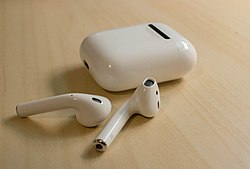| | |
 First-generation AirPods | |
| Developer | Apple |
|---|---|
| Manufacturer |
|
| Product family | AirPods |
| Type | Wireless earbuds |
| Release date |
|
| Discontinued |
|
| System on a chip | |
| Input | AirPods(each) Dual beam-forming microphones, dual optical sensors |
| Connectivity | AirPods(each) Bluetooth Charging case Lightning port (1st–3rd generation) [1] Qi (Wireless Charging Case for all models) MagSafe (Wireless Charging Case for 3rd generation) USB-C port (AirPods 4) Apple Watch charger (Wireless Charging Case for AirPods 4) |
| Current firmware | 1st gen: 6.8.8 [2] (December 2019) [3] 2nd gen: 6F21 [2] (October 22, 2024) 3rd gen: 6F21 [2] (October 22, 2024) AirPods 4 and ANC: 8B21 [2] (October 7, 2025) |
| Dimensions | AirPods(each) 0.65 x 0.71 x 1.59 in (16.5 x 18.0 x 40.5 mm) Charging case 1.74 x 0.84 x 2.11 in (44.3 x 21.3 x 53.5 mm) [1] |
| Weight | AirPods(each) 0.14 ounces (4.0 g) Charging case 1.34 ounces (38 g) [1] |
| Model Number | AirPods 4 (ANC) Model number: A3056, A3055, A3057 Year introduced: 2024 AirPods 4 Model number: A3053, A3050, A3054 Year introduced: 2024 AirPods 3 Model number: A2565, A2564 Year introduced: 2021 AirPods 2 Model number: A2032, A2031 Year introduced: 2019 AirPods 1 Model number: A1523, A1722 Year introduced: 2016 Wireless Charging Case for AirPods 4 (ANC) Model number: A3059 Year introduced: 2024 Charging Case for AirPods 4 Model number: A3058 Year introduced: 2024 Lightning Charging Case for AirPods Model number: A2897 Year introduced: 2022 MagSafe Charging Case for AirPods Model number: A2566 Year introduced: 2021 Wireless Charging Case Model number: A1938 Year introduced: 2019 Works with AirPods 2 and AirPods Lightning Charging Case Model number: A1602 Year introduced: 2016 Works with AirPods 2 and AirPods 1 |
| Related | AirPods Pro, AirPods Max |
| Website | apple.com/airpods |
AirPods are wireless Bluetooth earbuds designed by Apple. They were first announced on September 7, 2016, alongside the iPhone 7. Within two years, they became Apple's most popular accessory. [4] [5] AirPods are Apple's entry-level wireless headphones, sold alongside the AirPods Pro and AirPods Max.
Contents
- Models
- 1st generation
- 2nd generation
- 3rd generation
- AirPods 4
- Technical specifications
- Compatibility
- Support
- Sales
- Cultural impact
- Criticism
- Replacement for hearing aids
- Competition
- See also
- References
- External links
In addition to playing audio, the AirPods contain a microphone that filters out background noise as well as built-in accelerometers and optical sensors capable of detecting taps and pinches (e.g. double-tap or pinch to pause audio) and placement within the ear, which enables automatic pausing of audio when they are taken out of the ear. [6]
On March 20, 2019, Apple released the second-generation AirPods, which feature the H1 chip, longer talk time, and hands-free "Hey Siri" support. A higher-end version includes a charging case that supports Qi charging.
On October 26, 2021, Apple released the third-generation AirPods, which feature an external redesign with shorter stems similar to AirPods Pro, spatial audio, IPX4 water resistance, longer battery life, and MagSafe charging capability.
On September 9, 2024, Apple announced the AirPods 4, which feature the H2 chip, Bluetooth 5.3, and a USB-C charging case. A higher end model features active noise cancellation and a charging case that supports Qi and Apple Watch chargers. Additionally, after iOS 26, it enables real-time foreign language conversation through AI translation. [7] [8]



